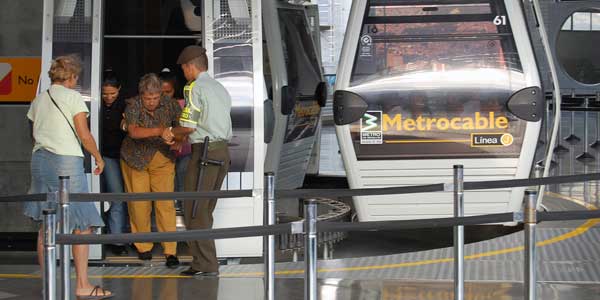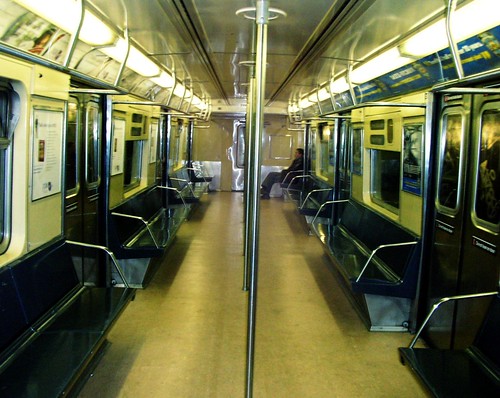One of the most common arguments against urban gondolas I hear is the issue of women’s safety.
The argument goes that women will not want to “be trapped” in a small box in the sky for fear of having to ride with another “sketchy” individual. Fair enough.
(I actually see this as a huge opportunity, but let’s get back to that problematic argument first.)
There are two common arguments used against this, both are useless:
- Argument 1: This issue is no different than waiting for a bus on a darkened corner; riding an elevator; riding a subway late at night; etc. The argument is useless because it is equivalent to saying “we’re no more scary than the other guys!”
- Argument 2: Urban gondolas are now equipped with closed circuit cameras and intercom systems. This argument is useless because it is a measure designed to deal with a problem after it’s already occurred.
The thing is, most public transit agencies use the exact same arguments and they never work! (Check out this article at Grist, to see how well those arguments hold up.)
These arguments tell people (women in particular) that their emotions are wrong; that statistics prove they are foolish for feeling the way they do. Telling people that their emotions are illegitimate is not the way to convince them of a product’s effectiveness and the entire public transit industry is complicit in this. I made that very mistake here.
Transit agencies love to demonstrate that public transportation is faster, safer, cheaper and better than the private automobile. So much so that telling people transit is good is an industry unto itself. And yet there isn’t a single city in North America where public transit is the transportation mode of choice for the majority of commuters.
Telling people what to think and how to feel just doesn’t cut it.
So here’s the opportunity: Why not design your cable system so that it actually makes people feel safer. And don’t use tricks, gimmicks or signage. Make it clearly, demonstrably safer than all the other options. Here’s how:
- Tactic 1: Fully automate your ticketing operations. This is already standard practice with a lot of transit systems, but should be standard practice with cable.
- Tactic 2: Use attendants at every station. This helps with loading, off-loading and passenger requests. You can afford these attendants because your cable transit vehicles are driverless and your ticketing operations are automated (Tactic 1). It should be noted, station attendants are standard on all urban gondola systems.
- Tactic 3: Use slim-profile stations. Small stations are easier to police and attend than large stations. Think streetcar platform small.
- Tactic 4: Stay low to the ground. Keeping your vehicles as low to the ground as possible increases access to emergency services.
- Tactic 5: Provide all-women cabins during daytime hours. This is a low-cost, easy policy to implement that has been used in cities around the world on traditional transit systems.
- Tactic 6: Provide single-rider/group cabins during evening hours. This, again, is a low-cost, easy policy to implement. Provide some means to communicate which vehicles are currently in “single-rider” use to prevent new passengers boarding at other stations.

Station Attendants not only provide increased security, they can assist those who require assistance entering and exiting a vehicle. Image by Steven Dale.
Tactic 6 is the most important because it increases both perceived and actual levels of safety for all because riders can self-segregate as they see fit. It is also a tactic that only CPT can offer. The reason cable alone can offer this is simple: Drivers are too busy driving to be attendants. And if you have drivers, you probably can’t afford attendants.
Furthermore, during off-peak hours, transit vehicles are mostly just empty seats. Because there are no drivers in the vehicles, there is little additional cost in providing single-rider/single-group cars. The small vehicle size of cable increases this capability.
Such tactics and policies are simple to create and easy to execute with almost no additional cost. By doing so, public transit can finally stop telling people they should feel safe and get to the real work of making them safe.
Creative Commons image by moriza.



10 Comments
An article about women’s safety coming from Montreal provides a good example of how cities can increase safety not only on public transit but public places as well.
In Montreal and Toronto, buses allow for women to get off at requested stops. New Metro stations in Montreal are also now surrounded by glass so women or anyone who may be in danger can be spotted easily and acted on quickly.
Montreal also tested out a pilot project on two neighbourhoods. They trained over 200 businesses and locals to be able to respond to women in danger. The goal was to was to increase urban safety, the mobility of women and the reduction of aggressive acts towards women.
It’s difficult to just focus on public transportation for safety issues. The best thing we can do is change the environment in which they use. Better urban design principles that focus on pedestrian safety, accessibility and circulation will provide that urban environment with a safer look and feel.
Its not just about looking at the public transit system its looking at the entire urban environment that will bring about a safer feel.
Montreal article can be found at
http://www.rapeis.org/activism/prevention/montreal.html
I haven’t actually seen people get on or off of CPT, why can’t it be like getting into an elevator?
Attendants at every station? Ouch. That’s a high labor cost that’s going to limit hours of operation severely.
Off peak, making every vehicle be single-party seems like a fair protocol.
The issue with boarding and alighting is complicated. Not every station necessarily needs an attendant, but in an urban situation, it’s probably necessary to keep people feeling at ease. It’s more perceptual than anything else, but it needn’t be so. At the same time, often operators/attendants often double as maintenance personnel which means that two costs are built into one. Total up the number of bus/LRT drivers + the number of maintenance personnel necessary and you see that the price isn’t much different.
Tactic 6 is actually a good argument for Cable Gondola PRT, that crazy concept I’ve discussed here before. If gondolas are small and take one to four passengers directly to their destination (we discussed a lot of low tech shunting), no one could get on at a subsequent station and assault you. Also, passing through a station every few minutes would provide an opportunity for intervention if an assault occurred.
“Tactic 5: Provide all-women cabins during daytime hours.”
Many white people find that being in proximity to black people makes them afraid or emotionally uncomfortable, and avoid public transit or certain other public spaces for this reason. Does this mean we should accommodate their irrational emotional response by providing “all-white cabins” (and public restrooms, and schools, etc)? Of course not! When people’s emotions are _wrong_, and statistics prove they are foolish for feeling the way they do, you should tell them their emotions are wrong, and do everything you can to get them to become less wrong. This is especially so when appeasing their irrationality leads to something as morally repugnant as segregation.
I think the two situations are somewhat different, I understand where you’re going, but I can’t concur. The simple reality is that most criminal assaults that occur between strangers are male-on-female. And such a problem is pronounced enough in certain areas of Asia that female-only subway/train cars are already a reality.
Would females be forced to use the female-only cars? Of course not. But they may be an unfortunate necessity.
I fully understand your desire to “tell them their emotions are wrong” but that’s no way to get people to come around to your way of thinking. Sometimes you need to give a little to get a little.